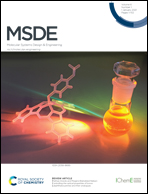Molecular engineering of 1,3,5-triaryl-2-pyrazoline fluorescent logic systems responsive to acidity and oxidisability and attachment to polymer beads†
Abstract
1,3,5-Triaryl-2-pyrazolines were designed, synthesised and covalently immobilised onto submillimetre TentaGel® polystyrene beads (functionalised with amino-terminated polyethyleneglycol ligands) by peptide bond formation. The molecules are modularly designed based on photoinduced electron transfer (PET) according to electron-donor–spacer–fluorophore–receptor and receptor1–spacer–fluorophore–receptor formats with ferrocene and N,N-dimethylaniline as the electron donor and receptor1. A reference fluorophore–receptor compound, associated with an internal charge transfer (ICT) mechanism, is included for comparison. A carboxylate moiety at the para-position of the 1-phenyl ring assists the molecules with aqueous solubility and serves as the site for covalent attachment to the polystyrene beads. The H+, Fe3+-driven INHIBIT, H+-driven off–on–off and H+-driven NOT logic systems are demonstrated in aqueous methanol and attached onto heterogeneous polymer submillimeter beads. The INHIBIT gate was tested with the stronger oxidant, ammonium persulfate, which resulted in a greater fluorescence quantum yield (Φf = 0.192). A double-tagged polymer bead integrating INHIBIT and off–on–off multi-valued logic was also prepared.



 Please wait while we load your content...
Please wait while we load your content...